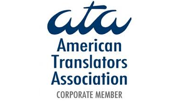July 19, 2013 by admin
Get a Free Quote
Our Accreditations





Recent Updates
Culture-bound syndromes and how language shapes illness
In her book Sleeping Beauties, neurologist Suzanne O’Sullivan explores the phenomenon of culture-bound illnesses around the world. The conditions she is interested in are psychosomatic disorders which arise due to a complex interaction between the mind and body, but… Read More
In terms of languages effortless is the way to go. In that respect, the odds seem in favour of a new English symbol, which may pop up on your screen really soon!
A new symbol, Ћ, has been created down-under to replace “the”. Since the article is one of the most commonly used words in English, it has been put forward that having a single symbol would make typing faster and easier, while saving space. Or so says the man who has already invested an incredible amount of money in the design of the symbol.
http://newsfeed.time.com/2013/07/10/why-the-deserves-a-symbol-all-its-own/
Call me old school, but the brilliant breakthrough thrills me not. Though there is something to the idea, I am not convinced Ћ will be used any time soon. Keyboards were thought through to make usage efficient and nobody could complain that the t-h-e sequence is hard to type. At least it seems to me that looking at your keyboard in search of the new symbol, which would probably hang alone somewhere on the side or require you to memorise a shortcut, or even worse, typing “the” out of habit and then having to insert Ћ instead, would end up being quite a waste of time.
I’m also worried that the symbol would actually make reading harder or look downright weird in Ћ middle of a sentence. The design may even appear confusing as it is clearly a ligature of T and H, and it may mislead people into thinking it actually stands for the “th” sound.
Also, dare I say it? I find the symbol unimaginative. It may look brand new but the letter actually exists in the Cyrillic alphabet. Perhaps a whole new design, closer to the Latin alphabet, would do a better job. I agree that having a specific symbol for a specific sound, the most difficult to achieve for anyone learning English, is in itself not non-sensical. Maybe then we should use the phonetic symbols for voiced and unvoiced “th”, so the spelling would be of help.
I wonder to what extent English, which uses an alphabet, could integrate symbols, rather like ideograms, to its writing system. Of course, some will argue that such a thing already exists and will happily mention the ampersand. However, & is only used in specific contexts. It is unclear whether there would be specific instances for the use of Ћ, at this stage it is not obvious.
Ћ goes in the opposite direction of what the Germans have been doing. German used to have an extra letter, ß, often mistaken for a Greek beta, which is now written as double s. Of course, there are exceptions. Trying to get them right may well have you scratch your head. The gloomy fate of the scharfes S, even after centuries of use, does not bode well. It goes to show that language and writing evolve at their own pace and that if a change is needed, it will spontaneously happen.
In the end, the real problem seems to be that typing does not offer the same liberties as writing. The bottom line is this: should our computers dictate the way we write?
Get a Free Quote
© 2024 All Rights Reserved
Rosetta Translation, 133 Whitechapel High St, London E1 7QA · 0207 248 2905
Comments
poin4d says:
yes, I totally agree with what you write thank you for the information ... I hope I can still read the article that you create thereafter ...
togel sgp
film semi
http://newpoin4d.blogspot.com/
Add Comment